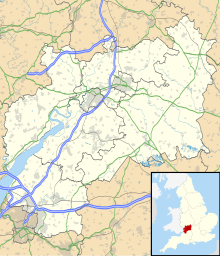Caerwood And Ashberry Goose House
| Site of Special Scientific Interest | |

Example - Lesser Horseshoe Bat (Rhinolophus hipposideros)
|
|
| Area of Search | Gloucestershire |
|---|---|
| Grid reference | ST54719655 & ST54649657 |
| Coordinates | 51°39′57″N 2°39′22″W / 51.665937°N 2.656165°WCoordinates: 51°39′57″N 2°39′22″W / 51.665937°N 2.656165°W |
| Interest | Biological |
| Area | 0.01 hectare |
| Notification | 1991 |
| Natural England website | |
Caerwood And Ashberry Goose House (ST54719655 ST54649657) is a 0.01-hectare (0.025-acre) biological Site of Special Scientific Interest in Gloucestershire, notified in 1991. The site was previously notified as Caerwood, Tidenham and lies within the Wye Valley Area of Outstanding Natural Beauty.
The site is notified for its nationally important breeding roosts of Lesser horseshoe bats (one of three sites in Gloucestershire). It lies at the top of the wooded gorge slopes of the Wye Valley, and at the southernmost tip of the Forest of Dean.
The site comprises one of a series of Sites of Special Scientific Interest within the Forest of Dean and Wye Valley (Gloucestershire and Monmouthshire). These sites support (between them) breeding and hibernation roosts for Lesser and Greater horseshoe bats. This is of European importance. Other sites in the group in Gloucestershire (all of which are SSSIs) include the breeding sites of Blaisdon Hall, Dean Hall Coach House & Cellar and Sylvan House Barn. Hibernation sites include Buckshraft Mine & Bradley Hill Railway Tunnel, Devil's Chapel Scowles, Old Bow And Old Ham Mines, Westbury Brook Ironstone Mine, and Wigpool Ironstone Mine.
...
Wikipedia

